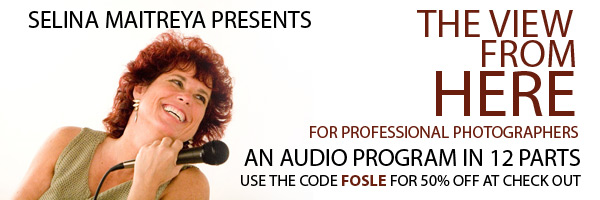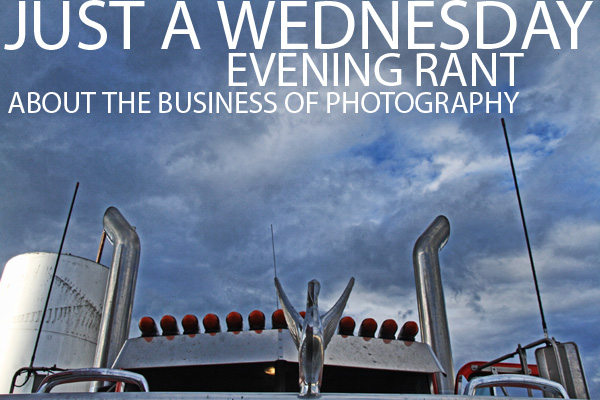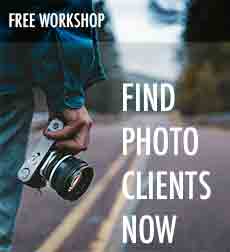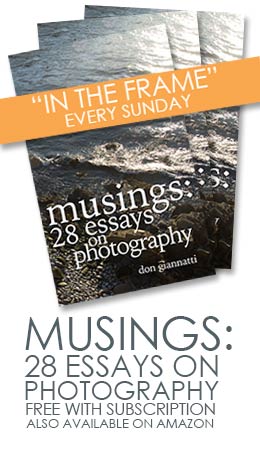Welcome Back.
We are back up and locked down.
I have had to remove Registrations for the time being, but will be adding a Newsletter signup for those of you who want to be ‘in the know’. At this time the magazine is still down, but it was very old content anyway.
We will continue on. A video shoot tomorrow for you all, and a darn great week coming up.
Thanks for all the kind words and tweets and emails, we are more energized than ever to keep LE going.
______________________
This is an unedited Rant. It may stray, but I am far too damn busy with the book to edit this.
I’ve threatened for the last year to post my thoughts on CODB as it relates to photography. I simply can’t do it… for whatever reason. Cost of Doing Business rules are all the rage on some forums these days.
But I don’t buy it. Not the way it is usually stated.
When I hear the stuff about ‘figure out what you need, then figure out what you need to charge per hour and how many hours you NEED to do to keep the roof on. Then you know how many gigs per week you need to do to make that CODB thing.
Bullshit.
That simply isn’t any way to predict that sort of thing.
It isn’t a ‘by the piece’ kinda business. An editorial assignment on Monday may be a full day and bill at 1/10th the full day ad shoot on Wednesday. And there are terrible months and amazing months. It is simply not x-amount of gigs at x-amount of dollars to meet overhead.
Please understand that I fully want photographers to know the Cost of Doing Business, and the analysis of cash flow that it entails. It’s the part about breaking it into hourly rates and how many hours where I feel the wheels come way off the tracks. I am NOT saying that photographers should be illiterate about what their costs of business are, only that those costs of business should NOT be used to figure out how much an image is worth.
If Joe lives in mom’s basement, and Tom has a studio, does that mean that a still life for Nordstrom’s is worth less if Joe does it? Is a photograph taken on location worth less because the photographer lives in a minivan and doesn’t charge for mileage? If I am ensconced in a daylight studio in Manhattan, is my image of a bottle of perfume worth more than a shot by a guy who lives in Brooklyn? Or Queens? Or Portland?
(Of course, we are not talking about expenses, so leave them out of it.)
I am image centric, business centric, advertising centric, value centric photographer. The answer is that it may be charged at a different rate, but that is not necessarily what the image is worth.
To me that still life shot has a value that is NOT related to the photographers financial situation. It has a value that is related to the ability of the photograph to drive more sales to Nordstrom… or increase their visibility, or bring in new customers. It has NO relationship to the how the photographer has decided to manage her business. It doesn’t care if it is an old photographer or a hip photographer or a woman photographer or a slightly ditzy, brain damaged unicorn. It. Doesn’t. Matter.
The image has a life and a value all its own. Intrinsic.
And pricing that image in relation to the photographers life choices is lame and short sighted at minimum. It creates an illusion instead of the reality of value.
One of the reasons that there are so many problems in the industry is that there has never been any kind of standardization, no ‘fee structure’ – no hierarchy of what the value of the work would be. Music has BMI and playwrights have publishers who protect their work, and lease it for fees that are structured. Movies are $9 a ticket whether it is Meryl Streep or Pauly Shore – a $2M crapper or a $200M blockbuster. It has a ‘street value’. DVD’s are all pretty much the same, whether Indie band, Classic or Hottest Hits. There may be a difference of 20-30% for some titles, but rarely more.
Photography has never been that way. Ever.
Photographers are cowboys all. A client can ask for a still life for a bridal magazine and get quotes from $250 to $10K… and more. I know. I was the CD of a very large agency. It was crazy when I bid photography. Far more crazy when I started getting bids in from other photographers. Bids would range in the hundreds of percent. And more. (One job had three bidders: $65K, $130K and $260K)
Will the image reflect that dollar expenditure? Probably not, the images were not that big of a technical challenge, and the concept was pretty straight forward. The difference is in the ‘fame’ of the photographer and the ethereal world of ‘prestige’. There are some astoundingly talented photographers in smaller markets all over the world, and they shoot for far friggin’ less than a few high level shooters who have a lot of fame, or even mid level shooters in major markets.
But the pictures are exquisite.
That makes the whole enterprise very hard to quantify.
And don’t bring up the different car models and the prices they bring argument… not the same thing. If you are going to a Kia agency, the cars will be pretty much in the same range for the same model.
Authors get a pretty standard set fee per book. It isn’t all over the map. It is pretty darned close. Unless they are really famous, or have slept with someone really famous.
But we decided long ago that photographers would be a far different, much more iconoclastic, every man for himself sort of business. I don’t know if it was a good idea or a bad idea, but it was our idea back when these things began. How it is working out may be seen differently from whatever perch you are sitting on.
I am not negative about the industry, I just feel that we must know what we are dealing with in order to manage both expectations and outcomes.

I could take a random, small group of photographers and hand out the exact same bid. And that small group of photographers would bid the same job for the same client in wildly diverse ways. (not counting air travel and such) and the interesting thing is that none would be wrong. And none right. Only pragmatic. Cowboys.
EDIT Added:
There are other market forces that come into play, naturally. The cost of living in Manhattan is a bit higher than in Denver. Some smaller markets have less cost of living than major markets. And all of that enters into the equation. But the differences are not hundreds of percentage points. Most products and services are priced pretty straight forwardly. So, yeah… living in SF you would expect a higher rate for the work. I hope this is clear. And again, I am not stating that one should NOT be knowledgable about this stuff, rather that they should be.
Zack’s approach is not a new one… not by a long shot. I started with model composites and did a hell of a business with them in Phoenix, and LA, then NY. But they did not sustain into a commercial world, so I had to work triple hard to get a new book put together for the types of clients that were paying for advertising.
What should I charge? Hell if I knew. In Phoenix, no one would share at first and then when I did find out what some of them were charging it made no eff’n sense at all.
How much is a full page ad for a tech firm for a trade magazine that may be used as a tech sheet for inserts in product boxes? Is it different if it is black and white? Is it different if it is shot on 4×5 or medium format? Is it worth more on 8×10 than on a 35mm? How long is a piece of string?
And while I share some of the trepidation of finding out that people shoot for free, I have yet to meet a photographer who started out at the kind of rates I work at these days. As you build up a ‘resume’ or client list, your perceived worth becomes much higher.
I once heard a photographer whining like crazy because his fees had ‘dried up’ (his words) to less than $2M per year. And for him that may have really hurt, but to me… well, I was unable to find my violin that day. Relativity and all…
Selina and I chat about this all the time. Photographers will spend a fortune for the latest lens or camera body, but spend nearly nothing for the tools of business. Getting ‘educated’ may reveal chinks in our thinking so we prefer to remain blind. Instead of taking a business class, money goes to another lens, or a new set of lights. Instead of finding a mentor, or hiring a consultant to help focus, money is wasted on a 6 color mailer to be ‘shotgunned’ out in a desperate attempt at self promotion.
Many photographers tell me that they ‘simply can’t get their arms around the business’ part and I simply laugh. Lame, seriously lame.
It ain’t rocket science. They ask more from their kids in school than they ask from themselves. Learning about business, finances, compound interest and cash flow is not hard. Not at all.
But we learn about business, we will have to then let go of that ‘excuse’ of not being business savvy when we do stupid things with our money. And if we fail… well then we can’t smile and kick the ground and opine over not having ever got our heads around the business end of it, cause, well… we are just so godammed creative. The belief that creative people cannot figure out a spreadsheet or cash flow is quite simply stupid, self defeating and bullshit.
Excuses are plentiful. Success is elusive.
Beer is good…
and people are crazy.






Absolutely agree with you, there’s no point on making a business who can’t be profitable or can’t cover basic needs such as housing, medical insurance, etc. for you and your family! This is the biggest aspect of what most of people undercutting themselves are unable to see that there’s a cost of operating a business and there’s also basic needs to be covered too, in the end we work to cover the basic needs to live our life too.
Cheers! Beer is good, too good. Especially when you have a 3 keg, 2 tap kegerator in the garage. Love your rants and raves. Eye openers for those who spend too much time drinking beer and playing on forums. There are musicians and actors that make nowhere near what the top performers made but are excellent. Some never make it. So the upcoming band that gets signed for a CD gets pennies for their work and the top act gets dollars, but the CDs sell in the same price range. Looks like photographers have been modeled after other arts where the experience, recognition and body of work have an impact on what can be charged. We have been led to believe that without this our work IS worth less than the next guy and so will bid accordingly to what we perceive is the worth of our experience and portfolio. And lets not forget that if you bid 10K for something and I come in and bid 1K then much less should be expected of me. More money, more expectations, more to deliver. Is it happy hour yet?
The cost-of-living thing is more of a reality check. If the fees don’t cover gear, rent, and food, somebody isn’t getting enough.
Love what you have to say here. I have seen some tools for pricing jobs based upon usage as opposed to what my costs are. They make much more sense. Getting standardized relevant pricing without “price fixing” is a challenge.
If the photographer are to create businesses that succeed, we do need some method of better pricing. Cost plus pricing is not going to work well. It might keep an individual from going bankrupt, but it drives prices into the basement.
Great rant!
Spend tons on gear and none on business sense? Yep.. The good news is I figured that out before I went down the rabbit hole too far. Right now I”m duplexing, trying to build a business AND learn business at the same time. Good news is that I have a day job while I try to sort everything out at a reasonable pace instead of trying to get it all while trying to really make a real living at it. But it’s coming together a bit more each day. Thanks for a good rant 😀
Good to have you back, Don